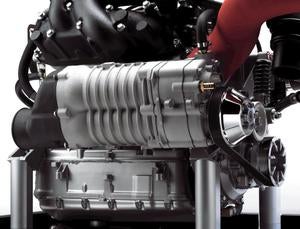Kawasaki Unveils Biggest Stock Power To Date
New Sport, Touring Models Feature 300 Horsepower
Kawasaki has once again leapfrogged the competition at the highest performance end of the market, unveiling two new Ultra models with engines rated at 300 horsepower. The triple digits are the largest horsepower number ever attached to a stock machine, adding 40 horses to the existing 260hp flagship engine.
The new models, dubbed the Ultra 300X and Ultra 300LX, highlight a five-model Kawasaki lineup for 2011.
3-0-0
Though the numbers may be new, the core engine that produces them remains Kawasaki’s familiar 1,498cc inline-four, dual overhead cam mill. The biggest change to the engine is an all-new supercharger that goes beyond the capabilities of the previous design. According to Kawi, the Roots-style superchargers used on previous models were known as fixed displacement units, producing large quantities of boost at all RPM levels, even right off idle, which resulted in a flat torque curve and usable power across the board.
 In addition to a huge 40-horsepower boost, the 2011 Ultra 300X and Ultra 300LX also dropped 40 pounds in overall weight.
In addition to a huge 40-horsepower boost, the 2011 Ultra 300X and Ultra 300LX also dropped 40 pounds in overall weight.The new supercharger, an Eaton Twin Vortices Series (TVS) Roots design, features twin four-lobe rotors and offers a significant performance increase over the previous unit. The biggest change is in the power delivery. The standard Roots unit delivered compressed air in waves. The new VTS design, however, offers continuous power delivery, resulting in not only more, but also smoother power. Boost pressure is up substantially, from the former 11.0 psi to 17.0 psi. The unit is also reportedly 30-percent more efficient, and limits mechanical losses to almost 30-percent. A liquid-cooled intercooler helps keep all that compressed intake charge cooled to prevent power-robbing heat from limiting the system’s efficiency.
 The Ultra 300LX handlebar pad has been scooped out to make room for a variety of handheld GPS devices.
The Ultra 300LX handlebar pad has been scooped out to make room for a variety of handheld GPS devices. Riders can tilt the nozzle to adjust the hull’s altitude.
Riders can tilt the nozzle to adjust the hull’s altitude. More power!
More power!The engine itself has been beefed up to accommodate the power. Pistons have been revised, and the valve train made stronger with hardened nickel valves and thicker stems, beefier cam chain, and reworked exhaust camshaft with new lobe profiles and better durability. Crankcases have been strenghtened to handle the increased power, and a more efficient oil cooler helps reduce temperatures by placing oil between two cooling jackets instead of one.
Electronic Throttle Additions
Like most high-end competitors, an electronic brain controls much of the engine’s inner workings. Kawi’s ECU controls injectors and throttle bodies to deliver the precise fuel/air mixture into the combustion chambers with assistance from a new electronic throttle. Electronic throttle also allows the Ultra to finally share the high-end features of its competition, like cruise control and no-wake modes, as well as fuel-saving and low-RPM slow modes.
The Ultra will also now sport electronic trim control. The nozzle of the boat’s 160mm jet can be tilted within an eight-degree span to adjust the hull’s attitude for the prevailing conditions, or highlight top speed or cornering ability. A new impeller and horizontal guide vanes on the propulsion gate are said to improve stability and hook-up during acceleration.
Updated Hull
The familiar Ultra hull returns, albeit with a number of tweaks. Kawi claims engineers reexamined “every inch” of the previous hull to improve strength and trim weight. Hull thickness has been decreased slightly throughout, while the bow area has received additional reinforcement. Sharper contours up front create a slightly more aggressive look. Overall, weight has dropped by almost 40 pounds.
Ergonomic changes also draw attention. A new instrument panel is said to be more easily visible than the previous design. The LCD display details the aforementioned riding mode displays, as well as typical functions like speed and rpm. Handlebars are adjustable to five positions, and overall width has been increased by about an inch. The change is to accommodate the new handlebar switch assemblies, but Kawasaki claims they also make the ride more comfortable. The reverse lever has also been redesigned, both for feel and easier operation.
Capacities continue to be massive on the Ultra, with 54 gallons of stowage below the front cowl and nearly 21 gallons in the fuel tank.
Additional features on the LX model include a more upscale paint scheme, scallped touring seat for greater support on long-distance rides, and chrome accents. Unique is the handlebar pad, which has been scooped out to accommodate a wide range of handheld GPS devices with the help of accessory hardware.
 We’re waiting with baited breath to hop aboard the new horsepower king.
We’re waiting with baited breath to hop aboard the new horsepower king.Returning Lineup
Three existing models return to the lineup, including the 800 SX-R standup, the STX-15F entry-level model, and the Ultra LX. There had been speculation that the stand-up 800 had been dropped from the line, but it appears enthusiasts will have one more year to jump on the standup bandwagon before two-stroke emissioins ruling regulates their engines out of existence
Get PersonalWatercraft.com in your Inbox!
Like PersonalWatercraft.com on Facebook
Comments
Most Popular

Remembering the Sea-Doo XP

2025 Yamaha JetBlaster PRO 2-Up Review

2024 Yamaha GP HO Review

2008 Kawasaki Jet Ski Ultra 250X Review

2024 Kawasaki Jet Ski STX 160X Review











 Your Privacy Choices
Your Privacy Choices